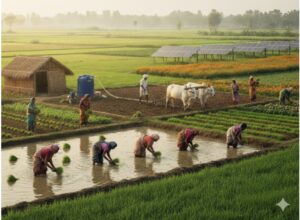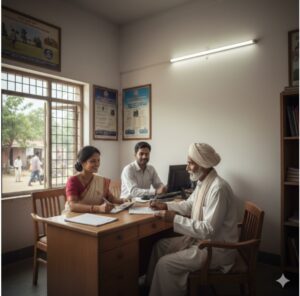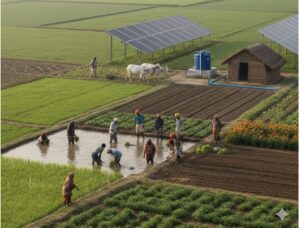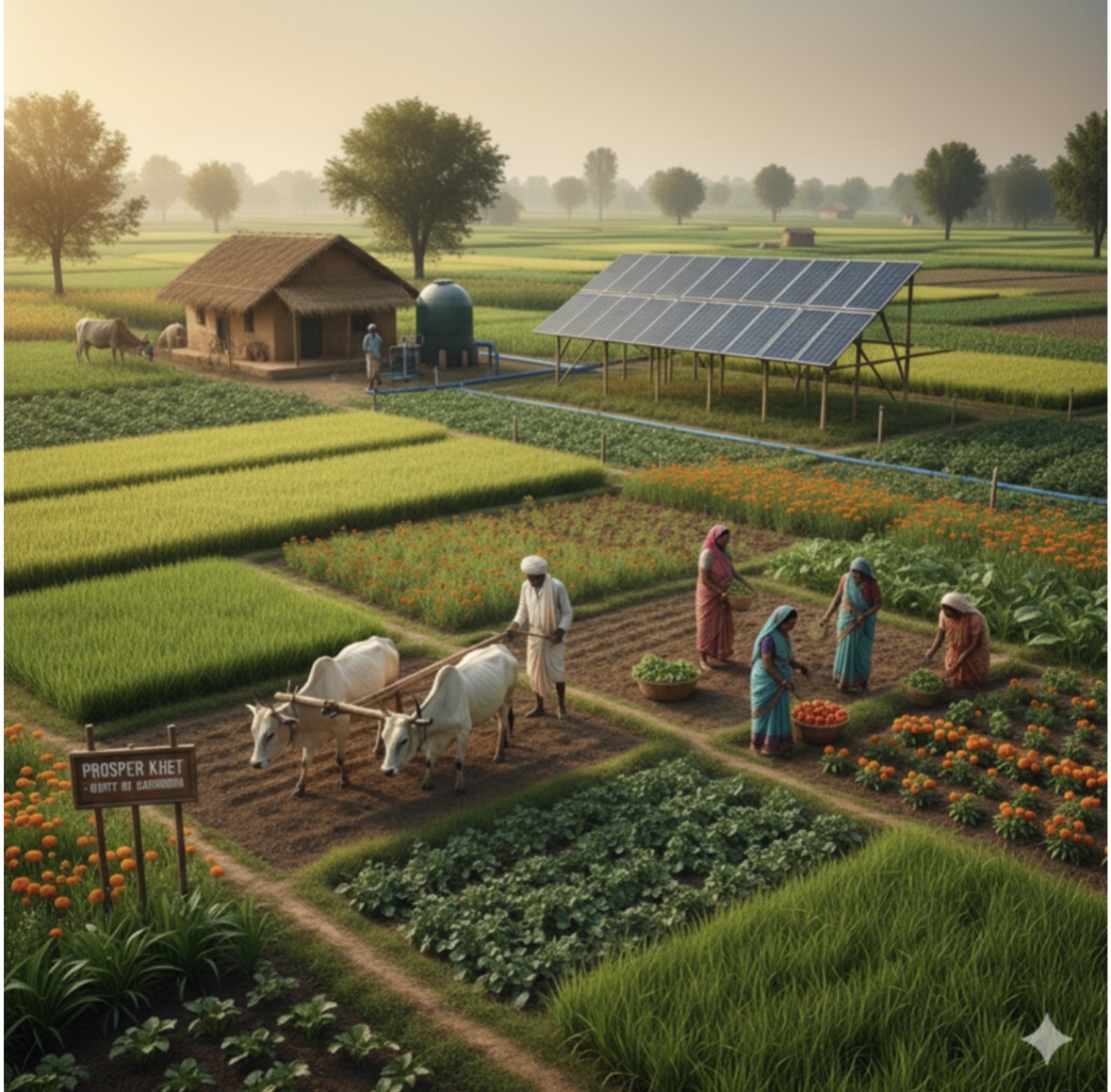Sustainable agriculture is no longer a niche aspiration — it’s becoming central to how India funds its food future. As climate risks, soil degradation, and market shocks intensify, financiers, policymakers, and farmers are shifting capital toward practices that increase productivity while protecting ecosystems. This transition is evident in the rise of green debt markets, the expansion of agricultural credit, and the introduction of new public schemes designed to support climate-resilient farming.
Why is sustainable agriculture finance necessary now?
India’s farm sector supports nearly half the workforce but faces mounting stress from extreme weather and input-cost inflation. Financing models that reward water-efficient irrigation, regenerative soil management, agroforestry, and renewable energy on farms reduce long-term risk for both lenders and producers. Between FY2020-21 and FY2021-22, tracked financial flows into activities the Climate Policy Initiative classifies under sustainable agriculture averaged about ₹22,393 billion (≈USD 301 billion) per year, a clear sign that both public and private money are already moving into sustainability-aligned uses.

Public support + Private capital: A blended push
Public budgets and banks remain the backbone of agricultural finance in India, but the composition is evolving. Government budget allocations and public sector undertakings supplied roughly one-third of those sustainable agriculture flows in the CPI study, while commercial financial institutions provided the lion’s share of private debt. This mix matters: public programmes de-risk new technologies, enabling private lenders to scale loans for solar pumps, precision inputs, and storage that reduce post-harvest losses.
At the same time, India’s broader green debt market is growing. As of December 2024, India’s cumulative aligned green, social, and sustainability (GSS+) debt reached approximately USD 55.9 billion, marking a rapid expansion that creates opportunities for climate-smart agri projects to tap into institutional investors seeking impact, as mentioned in the Climate Bonds Initiative’s 2024 report.
Agricultural credit at scale and shifting in quality
Access to credit is improving in absolute terms: ground-level agriculture credit hit about ₹19.28 lakh crore by December 31, 2024, against a FY25 target of ₹27.5 lakh crore, demonstrating banks’ willingness to provide large volumes of farm finance. While much of this remains short-term crop loans, regulators and development banks are nudging a portion of flows toward longer-term, sustainability-oriented lending such as watershed investments, on-farm renewable energy, and warehouse upgrades that enable better price realisation for farmers.
NABARD and other development institutions play a central role: their credit planning and refinance windows help scale innovations at the last mile, pairing technical assistance with concessional finance to make sustainable agriculture practices bankable.

Policy levers accelerating sustainable agriculture finance!
Two policy trends are particularly catalytic!
First, India’s draft climate finance taxonomy provides a framework to classify and direct capital toward low-emission and adaptation activities — including many agri investments — thereby reducing greenwashing and clarifying which projects qualify for “green” finance.
Second, recent budgetary increases and targeted schemes for climate-resilient agriculture signal sustained public intent to subsidise transition costs for smallholders. Together, these measures improve investor confidence and create standardised pipelines for sustainable agriculture projects.
Agriwise: Enabling sustainable agriculture through green finance
Agriwise is leading this transition with enabling farmers and agri-enterprises to access finance that supports eco-friendly practices. The company offers solar loans that empower farmers to transition from diesel-based irrigation to renewable energy, thereby significantly reducing fuel costs and carbon emissions.
Beyond solar financing, Agriwise provides structured warehouse receipt finance and customised working capital solutions for agribusinesses adopting sustainable models. By aligning credit products with long-term sustainability goals, Agriwise ensures that farmers not only secure capital but also build climate resilience. Its approach demonstrates how financial innovation can make sustainable agriculture both profitable and scalable across India’s diverse agri value chains.

Challenges & where opportunity lies!
Despite momentum, gaps remain. The CPI analysis highlights that domestic commercial banks account for most private sustainable agriculture finance due to priority-sector lending obligations, which can mask genuine market-driven investments and leave project-level green finance underdeveloped. Data limitations also make it hard to track the exact end-use of many loans, complicating impact measurement. Overcoming these hurdles — through stronger reporting standards, blended finance instruments, and aggregation vehicles for smallholder projects — would unlock institutional capital on a larger scale.
What does this mean for lenders?
For agribusinesses and lenders, the practical steps are clear: (1) structure products that link credit terms to measurable sustainability outcomes (soil health, water savings, emissions reduction); (2) use blended capital to lower first-loss risks for pilots; and (3) invest in data and verification to prove impact. For farmers, access to affordable loans for drip irrigation, bio-inputs, on-farm solar, and quality storage can raise yields and buffer climate shocks — making sustainable agriculture both a resilience strategy and a business proposition.

Conclusion
India’s shift toward sustainable agriculture finance is already underway, as evidenced by substantial tracked flows, expanding green debt markets, and rising agricultural credit targets. The next phase will require standardisation, better measurement, and creative finance structures that align farmer incentives with long-term ecosystem health. If policymakers, lenders, and agribusinesses coordinate effectively, sustainable agriculture can transition from a policy slogan to a mainstream investment that secures incomes, food supplies, and the environment for decades to come.
Disclaimer
The content published on this blog is provided solely for informational and educational purposes and is not intended as professional or legal advice. While we strive to ensure the accuracy and reliability of the information presented, Agriwise make no representations or warranties of any kind, express or implied, about the completeness, accuracy, suitability, or availability with respect to the blog content or the information, products, services, or related graphics contained in the blog for any purpose. Any reliance you place on such information is therefore strictly at your own risk. Readers are encouraged to consult qualified agricultural experts, agronomists, or relevant professionals before making any decisions based on the information provided herein. Agriwise, its authors, contributors, and affiliates shall not be held liable for any loss or damage, including without limitation, indirect or consequential loss or damage, or any loss or damage whatsoever arising from reliance on information contained in this blog. Through this blog, you may be able to link to other websites that are not under the control of Agriwise. We have no control over the nature, content, and availability of those sites and inclusion of any links does not necessarily imply a recommendation or endorsement of the views expressed within them. We reserve the right to modify, update, or remove blog content at any time without prior notice.



